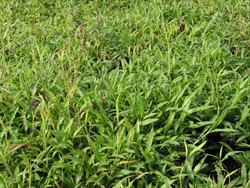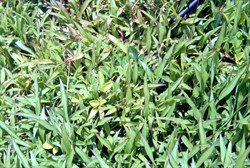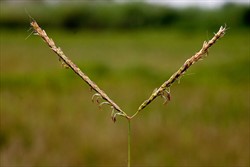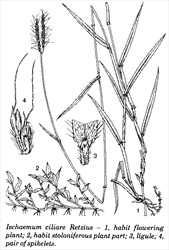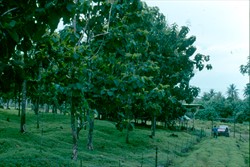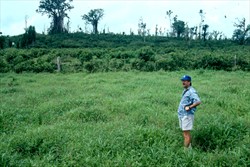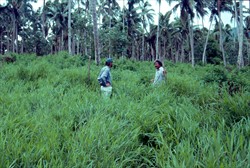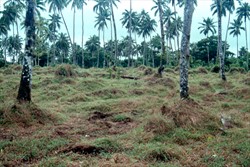Ischaemum ciliare
Tropical Forages
Ischaemum ciliare Retz.
Ischaemum aristatum auct.; Ischaemum ciliare subvar. villosum (Nees) Hack.; Ischaemum indicum auct.; Spodiopogon villosus Nees
Family: Poaceae (alt. Gramineae) subfamily: Panicoideae tribe: Andropogoneae subtribe: Ischaeminae.
Tufted or spreading stoloniferous perennial, rooting freely at the lower nodes, and forming a dense mat under regular defoliation. Culms prostrate, geniculate or erect, often branching, 0.2–0.6 (rarely 0.9–1.3) m tall, nodes bearded. Leaves grey green sometimes with purple-coloured margins; leaf sheath often tight, node bearded, otherwise sparsely hairy to glabrous; ligule membranous, truncate, 1–2 mm long; leaf blade narrowly lanceolate, 5–30 (–60) cm long and 0.3–1 (–2) cm wide, acuminate at apex, usually sparsely to densely hairy; leaf base broadly rounded. Inflorescence well exserted, comprising 1 or 2 terminal racemes 2–10 cm long, breaking up at maturity; spikelets bisexual, 3–5 mm long with twisted geniculate awn 8–15 mm long on upper lemma, paired (one sessile, one pedicellate), spikelet pairs inserted alternately along the flattened triangular rachis. c. 600,000 seed units/kg (1 seed unit = sessile spikelet + pedicellate spikelet + awn).
Similar species
I. ciliare: rounded leaf base; wings on keel of lower glume of the sessile spikelet prominent (0.2–0.7 mm wide); apex of lower glume comprising two rounded lobes; nodal hairs usually longer than 2 mm, spreading; axillary inflorescences uncommon.
I. timorense: constricted, petiole-like leaf base; wings on keel of lower glume of the sessile spikelet absent or <0.2 mm wide; apex of lower glume sharply bicuspidate), nodal hairs to 1.5 mm long, antrorse (pointing upwards); axillary inflorescences common.
Asia: 细毛鸭嘴草 xi mao ya zui cao (China); bara toriya-gadi, guhera, kala, paba, piyana-koru-gadi (India); blemblem, rumput padang (Indonesia); ຫລັກນາ, ຫຼັກນາ, lak na (Laos); rumput gerek telinga (Malaysia); ya wai (E), ya-yonhu (S)(Thailand); môm an, cỏ lông sương, cỏ mạng nhẹn, môm ân, cỏ mật rìa (Vietnam)
English: batiki bluegrass, (m)balanga grass (Fiji); indian murainagrass (USA); toco grass (Trinidad); toto grass (Surinam); smut grass
Latin America: pasto batiki, pasto ratana (rattana, retana, rotana) (Spanish)
Note: A number of these common names may also be applied to other Ischaemum spp. and Polytrias indica (Houtt.) Veldkamp that bear a superficial resemblance to I. ciliare
Native:
Asia: Bangladesh; China (southeast); India; Laos; Malaysia (peninsular); Myanmar; Sri Lanka; Taiwan; Thailand; Vietnam
Naturalized:
West Africa, tropical America and the Pacific Islands
Cultivated:
Also cultivated.
Forage
Permanent pasture and good ground cover with rapid spread from cuttings giving good competition against annual weeds after soil disturbance or clearing of forest. Moderate but stable production on poor soils on sloping land. Could be used for cut-and-carry.
Environment
Soil conservation on slopes in high rainfall areas.
Other
Often used as a turf.
Found in open, grassy glades in lowland forests, roadsides, ditch banks, pond margins, and lawns.
Soil requirements
Adapted across a wide range of soil textures (except on sandy or coralline soils), fertility levels and soil reaction; pH (4.5–) 5.5–7 (–8). It is especially useful on very acid, low fertility soils with high Al, and can tolerate poor drainage and some salinity.
Moisture
Although a variable species and sometimes found in seasonally dry monsoonal regions, I. ciliare has greatest application in the wet tropics with up to 7,000 mm rainfall. It is not drought tolerant, but has good flood tolerance.
Temperature
I. ciliare grows best in the lowland tropics, although it extends to >600 m asl in Costa Rica and Western Samoa. It is unproductive in cooler environments, having an optimum growing temperature between 30 and 35 ºC and no frost tolerance.
Light
It is moderately shade tolerant remaining productive and persistent with light transmission as low as 40%, performing well under coconut.
Reproductive development
Flowering response is variable, with reports of flowering throughout the year in Malaysia (near the equator), in June-July in Thailand, and in July-August and January-February in India (both north of the equator), and April-May in Fiji (south of the equator).
Defoliation
Requires regular defoliation since quality declines rapidly with age of regrowth. It is very tolerant of heavy grazing. Generally more effective as a weed suppressant than some of the more productive species such as Urochloa decumbens. However, constant heavy grazing may allow invasion of annual weeds and aggressive perennial species such as navua sedge (Cyperus aromaticus/Kyllinga polyphylla) and giant sensitive plant (Mimosa diplotricha, formerly M. invisa) .
Fire
Not usually relevant in high rainfall areas.
Guidelines for establishment and management of sown forages.
Establishment
Normally established vegetatively to achieve rapid ground cover and weed suppression, and because seed production is unreliable. Cuttings can be broadcast onto the soil surface and disced in, or planted on a 30 cm grid. Seed shows dormancy for up to 6 months after harvest, with germination continuing to improve for up to 10 months under good storage conditions. Seedlings are vigorous.
Fertilizer
Competes with associated coconuts (Cocos nucifera) for N and P. Responds to low levels of applied N, but response declines with increasing levels, from 16 kg DM/kg N at 75 kg/ha N, to 7 kg DM/kg N at 225 kg/ha N. CP levels increase with increasing rates of N. Responses to P have been measured in associated legumes, but not in the grass.
Compatibility (with other species)
I. ciliare is a competitive grass, suppressing most associated species, although forming stable mixtures with some legumes. Very effective in suppression of weedy species, Hyptis capitata and Chromolaena odorata, but not Cyperus aromaticus/Kyllinga polyphylla.
Companion species
Grasses: May be grown in similar conditions to the more aggressive and productive Hemarthria altissima and Urochloa humidicola.
Legumes: Grona heterophylla, G. triflora, Mimosa pudica.
Pests and diseases
In Asia and Papua New Guinea, flowers can be infected with a smut (Sphacelotheca ischaemicola), which causes failure of inflorescence to emerge. In Costa Rica, productivity in periods of high rainfall is reduced by attack by spittlebug (Aenolamia sp. Homoptera: Cercopidae). Leaf blotch is commonly seen on leaves during wet weather.
Ability to spread
Rapid local spread through stolons, pieces of which may be transferred between cloven hooves. Seed does not spread by wind.
Weed potential
Ability to spread through long stolons can make it a weed of cultivated land. Not considered to be an environmental invasive by the Pacific Island Ecosystems at Risk (PIER) group.
Nutritive value
Soft leaf of reasonable nutritional value but likely to be limited on low fertility soils. CP values range from 18% in 10-day regrowth, to 14% at 3 weeks, 11% at 6 weeks, 8% at 8 weeks, and 6% or below in mature foliage. Average IVDMD of 5-week regrowth measured at 59%.
Palatability/acceptability
Palatable and readily eaten.
Toxicity
No reports of toxicity, but suspected of causing milk taint.
Dry matter
Reported dry matter yields range from 3 to 20 (–27) t/ha DM. Usually harvested by grazing animals but capable of about 10 t/ha DM under high rainfall.
Animal production
Liveweight gains of 0.4–0.5 kg/head/day have been recorded during the growing season, but in cooler/drier periods, productivity may fall to below zero. Milk production is poor, and even with supplements, only 6–7 kg/head/day is achieved with 3–4 cows/ha. Higher productivity is achieved with more rapid grazing rotation.
2n = 18, 54 (20, 36, 72).
Seed set is unreliable, and harvesting and drying tend to be difficult under high rainfall conditions. Smut fungus can have a significant effect on potential seed yields. Seed storage also presents problems in the hot, humid environments where I. ciliare is mostly grown.
No specific information available.
- Palatable.
- Tolerant of heavy grazing.
- Adapted to acid, low fertility soils.
- Tolerant of waterlogging.
- Good ground cover/weed suppression.
- Low to moderate productivity.
- Mediocre quality.
- Poor drought tolerance.
- No cold tolerance.
Arosemena, E., Pezo, D.A., Kass, D.L. and Argel, P.J. (1996) Requerimientos externos de fósforo en pasto ratana (Ischaemum indicum (Houtt.) Merrill) y Brachiaria brizantha (A. Rich.) Stapf. Pasturas Tropicales 18:34–40. bit.ly/2QSqV22
Baki, B.B., Ipor, I.B. and Manidool, C. (1992) Ischaemum ciliare Retzius. In: Mannetje, L.’t and Jones, R.M. (eds) Plant Resources of South-East Asia No. 4. Forages. Pudoc Scientific Publishers, Wageningen, the Netherlands. p. 142–144. edepot.wur.nl/327785
Gilliland, H.B., Holttum, R.E. and Bor, N.L. (1971) Grasses of Malaya (A revised flora of Malaya Volume III). The Botanic Gardens, Singapore.
None released.
None reported.
